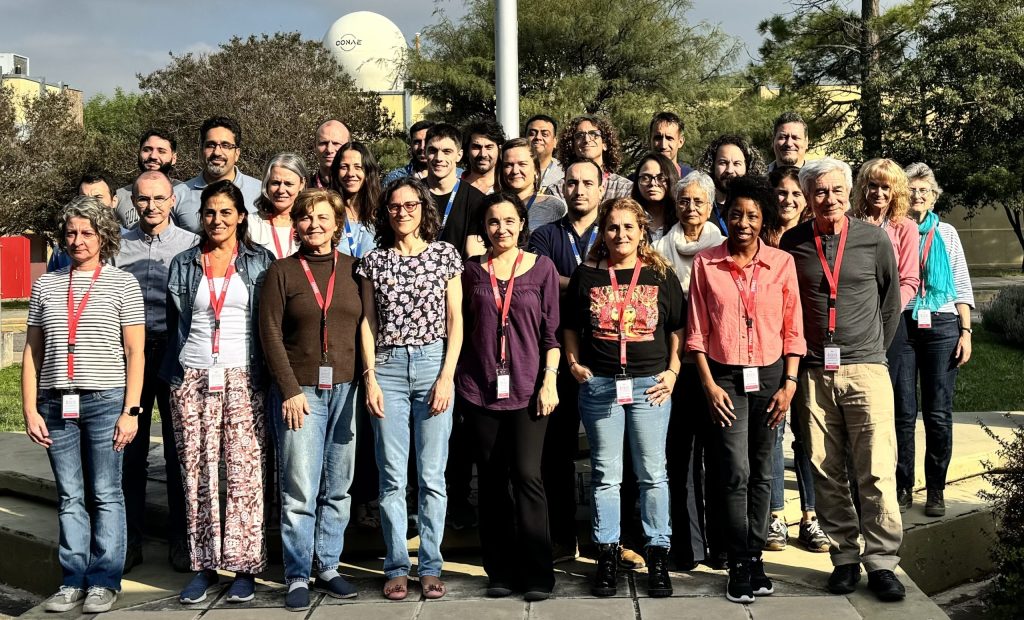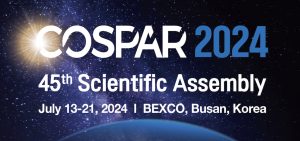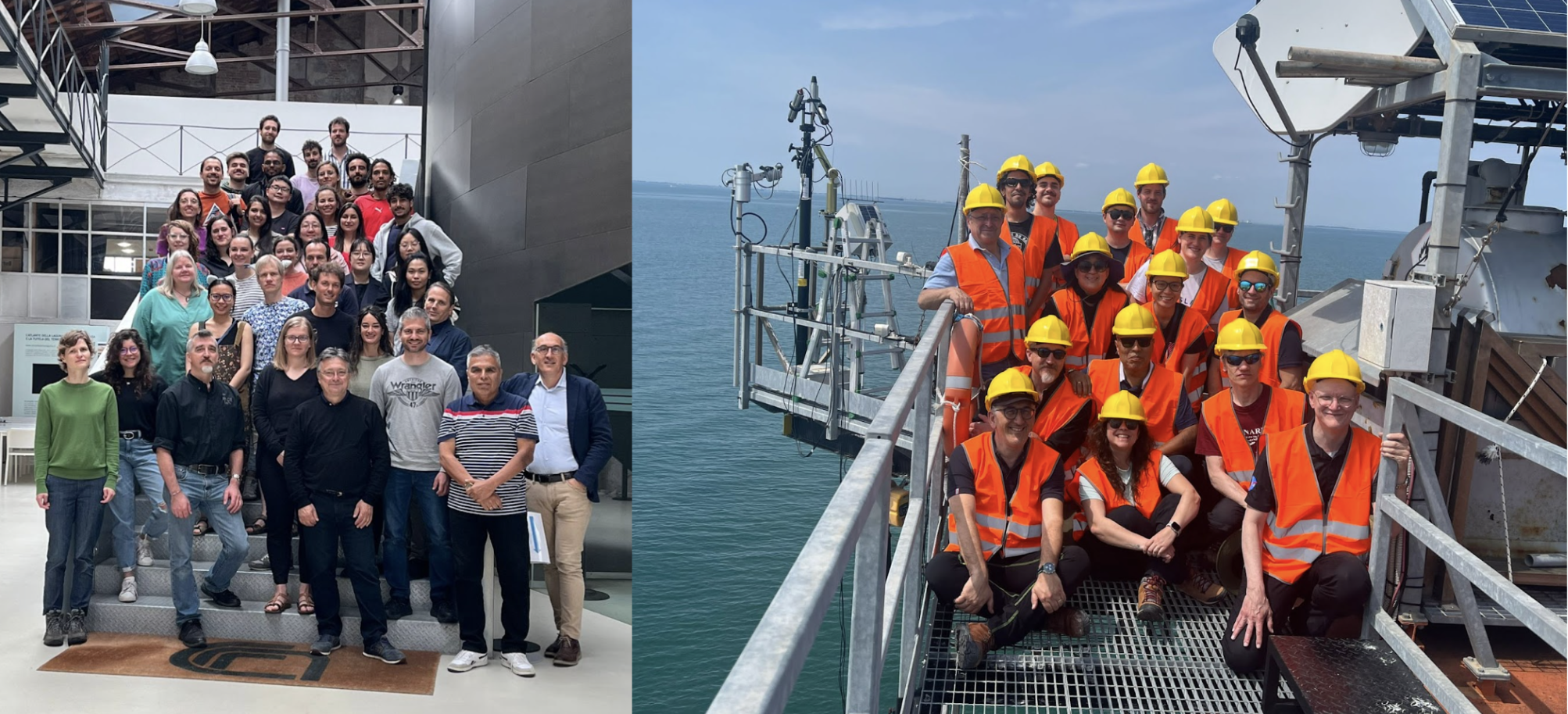IOCCG news bulletins include items of interest from the IOCCG, its sponsoring agencies, and the broader ocean colour community. Please let us know if there are any other items of interest you would like to see included in the next IOCCG news bulletin by contacting Raisha Lovindeer (raisha@ioccg.org).
News from IOCCG
28th IOCCG Committee Meeting + Satellite Ocean Colour Validation Training
The 28th IOCCG Committee Meeting was held in hybrid format from 24 – 26 April 2024, hosted by the Argentina National Space Activities Commission (CONAE) at the Teófilo Tabanera Space Center (CETT) in Córdoba, Argentina.

Participants of the IOCCG training of Satellite Ocean Colour Validation, hosted at CETT, Argentina, April 2024.
The meeting was preceded by an in-person training session from 22-23 April on Satellite Ocean Colour Validation at the request of CONAE, conducted by IOCCG members. The training was attended by 22 local and regional participants from Argentina and Brazil.
A report from the training is available on the IOCCG website.
At the Committee meeting that followed, members discussed action items around a suite of scientific activities, including new recommendations emerging from the IOCS-2023 meeting (see below); collaborative efforts with CEOS groups and future CEOS work plans; task force and working group activities; new plans for ocean colour protocols; strategies for creating reliable long-term time series data; strategies for improving the carbon footprint of the IOCCG; and strategies for contributing to the direction of future satellite missions. The minutes of the meeting will be made available on the IOCCG Committee meetings’ webpage once finalized.
The IOCCG has decided to hold virtual committee meetings during years when the group convenes an International Ocean Colour Science meeting. Therefore, the 29th IOCCG Committee meeting will be held virtually, in the spring of 2025.
IOCCG Committee Member Rotations
One of the requirements of being an affiliated program of SCOR is the regular rotation of IOCCG Committee members, who serve 3-year terms. Ana Dogliotti (IAFE/CONICET, Argentina) has completed one term, but will remain on the IOCCG Committee for a second term. Hubert Loisel (Université du Littoral, France) rotated off the Committee at the end of the meeting in April. The entire IOCCG Committee thanks him for his valuable contribution over the past several years.
We also extend a warm welcome to our new IOCCG Committee member Bob Brewin (University of Exeter, UK) who joins the IOCCG as a scientific member, with experience across a range of water types.
Date & location of IOCS-2025
 The 6th International Ocean Colour Science (IOCS) meeting is scheduled for the first week of December 2025, hosted by EUMETSAT and ESA. We will return to the venue of the very first IOCS meeting, in Darmstadt, Germany.
The 6th International Ocean Colour Science (IOCS) meeting is scheduled for the first week of December 2025, hosted by EUMETSAT and ESA. We will return to the venue of the very first IOCS meeting, in Darmstadt, Germany.
All presentations and the proceedings of the IOCS-2023 meeting are now available on the meeting’s website at https://iocs.ioccg.org/iocs-2023-meeting/
Call for Proposals to Tackle IOCS Community Recommendations
Five IOCS meetings have been convened by the IOCCG since 2013, hosted by the IOCCG sponsoring agencies. During these meetings, breakout workshops dedicated to various pressing issues across ocean colour science have been convened and recommendations made for the way forward. While some of these recommendations are aimed at the IOCCG or space agencies, a vast number of recommendations are aimed at the ocean colour community, to help to improve the science around particular topics. Community recommendations are now available on the IOCS website, to help guide the community on gaps and research needs. A small number from IOCS-2023 are still to be added after a second review by the breakout workshop co-chairs.
IOCCG welcomes submissions of proposals for working groups and task forces that aim to address OPEN community recommendations from the IOCS meetings. Open recommendations are those not already being actioned by existing IOCCG working groups, task forces, or community members (labeled as OPEN on the website). These include recommendations within the following topics outlined on the IOCS-recommendations page:
- Lidar
- User Needs
- Geostationary (see section under Resolution – spectral, spatial, temporal on the website)
Proposals for working groups should outline a plan for an IOCCG Scientific Report as the output, to be completed within 2-3 years (see example), whereas proposals for task forces should outline actions for implementation across 3 or more years. Proposals are accepted on a rolling basis, however those wishing to be reviewed and considered before the next IOCCG Committee meeting should be submitted no later than 31 December 2024.
Links to the US Decadal Survey
One primary way that NASA and NOAA collect community input to determine future priorities is through the US Decadal Survey, conducted by the US National Research Council. The last survey was conducted in 2017, with the next survey expected in 2027. Community input for the survey is obtained through the submission of white papers outlining which components of the Earth’s system should be measured or monitored, and why.
IOCCG encourages current IOCCG working groups and task forces, proposers of new working groups or task forces, as well as other individuals or small teams, to lead the drafting of a white paper under a particular IOCS-recommendation topic OR from recommendations emerging from existing IOCCG Reports. Drafting of a white paper will include synthesizing the existing recommendations and gaps under your particular topic, and adding in relevant supporting material. Those interested in leading or contributing to drafting a white paper are asked to register your interest by emailing the IOCCG Project Coordinator (raisha@ioccg.org) at any time, but preferably before the end of 2024.
60-Day Comment Period Still Open for DOC Protocols
A draft version of the protocol entitled “Dissolved Organic Matter Sampling and Measurement Protocols: Consensus Towards Future Ocean Color Missions“, is still available for community comment until 15 July 2024. This community protocol document on dissolved organic carbon measurements aims to integrate the latest advances in sampling, instrument measurement, and data analysis to provide reliable DOC values and uncertainties to support ocean colour satellite algorithm development and validation, as well as carbon cycle studies for inland, coastal, and ocean waters. See the website and submit your comments by e-mail to protocols-ioccg@oceancolor.gsfc.nasa.gov by the deadline.
2024 IOCCG Summer Lecture Series
A total of 126 applications were received for the 6th IOCCG Summer Lecture Series, being held from 4 – 16 November 2024 in Hyderabad, India, hosted by INCOIS. The number of students selected was slightly larger than in previous years—30 students from 18 countries.
As in previous years, several distinguished research scientists are lined up to provide lectures on the fundamentals of ocean optics, bio-optics and ocean colour remote sensing, with focus on current critical issues. In addition to the practicals on fundamentals and those to understand data from the Copernicus Sentinel series, hyperspectral data from the newly launched PACE mission has also been added. Students will have ample time with lecturers over the two-week period for in-depth discussion of the material, as well as their own scientific research.
Training: GOCI Toolbox (GTBX) on Snap
 As part of IOCCG support for the 45th Committee on Space Research (COSPAR) Scientific Assembly, KIOST and the Korea Hydrographic and Oceanographic Agency (KHOA) will be conducting an in-person training course, GOCI Toolbox (GTBX) on Snap, on 18 July from 9:00 – 12:30 local time (personal laptop required), and an exhibition on GOCI-II data from 14 – 18 July. Both are open to meeting participants. Sign-up for the course is available here, through the IOCCG website. The Assembly will be held in Busan, South Korea from 13 – 21 July 2024.
As part of IOCCG support for the 45th Committee on Space Research (COSPAR) Scientific Assembly, KIOST and the Korea Hydrographic and Oceanographic Agency (KHOA) will be conducting an in-person training course, GOCI Toolbox (GTBX) on Snap, on 18 July from 9:00 – 12:30 local time (personal laptop required), and an exhibition on GOCI-II data from 14 – 18 July. Both are open to meeting participants. Sign-up for the course is available here, through the IOCCG website. The Assembly will be held in Busan, South Korea from 13 – 21 July 2024.
A session on ocean colour will also be available within theme A2.1: Science And Applications Enabled By Satellite Missions For Global Ocean, Inland Seas, And Cryosphere. Session title: Progress in development and exploitation of satellite ocean colour and optical imagery on 15 July, 11:00 – 12:30 local time, chaired by Jongkuk Choi.
News from NASA
PACE Mission Launched

First image released from OCI. Image identifies two different communities of phytoplankton off the coast of South Africa on Feb. 28, 2024. The central panel shows Synechococcus in pink and picoeukaryotes in green. The left panel shows a natural color view of the ocean, and the right panel displays the concentration of chlorophyll-a. Credit: NASA
The Plankton, Aerosol, Cloud ocean Ecosystem (PACE) mission was successfully launched on 8 February 2024. NASA is now receiving data from all instruments aboard the satellite. Data calibration and validation is on-going but preliminary assessments are very positive. Updates on the mission, including stunning first images, are all available through the PACE website.
Provisional data is now available on the Earth Data Search platform (https://www.earthdata.nasa.gov/learn/earthdata-search). This table on the PACE website shows the data products and the status of their release. All test products are currently on the website as provisional as calibration has not been completed. The validation science team has been assembled, and many validation exercises are underway or scheduled for 2024 and beyond.
NASA and the Ocean Carbon & Biogeochemistry (OCB) Program are hosting a one-week coding sprint (hackweek) from 4-8 August 2024 at the University of Maryland, Baltimore County (UMBC). The event will include tutorials and coding that will kick-start research using the data streams generated by the OCI, SPEXone, and HARP2 instruments aboard PACE. Outcomes of the hackweek will be made available online for public access, along with tutorials on how to handle PACE’s large datasets.
News from EUMETSAT
FRM4SOC-2: Updates
The overarching goal of FRM4SOC-2 is to promote the adoption of fiducial reference measurement (FRM) principles across the OC community. In the frame of running the first extension of the second phase, our main objective is to become closer to the community, broadcasting the knowledge, as well as bringing the recommendations, guidelines and tools created in the frame of the project closer to users.
First Copernicus FRM4SOC 2024 training (FICE2024)
The first Copernicus FRM4SOC 2024 training (FICE2024) was held in Venice at CNR-ISMAR From 6 – 17 May 2024. Thirty-one participants were trained in the principles of above water radiometry, derivation of uncertainty budgets, and protocols for matchup analysis with satellite data. The course included field work at the Acqua-Alta Tower, processing of data collected with the HyperCP community processor, tutorials on the use of Sentinel-3 data, and matchup analysis with the ThoMaS toolkit. Participants were successful in processing the data they collected from the tower, as well as data they brought from their own field campaigns. They had the opportunity to exchange with experts from the FRM4SOC project about their future plans for in situ data collection, and were encouraged to continue to collaborate with the network established during the training. EUMETSAT wishes to thank Vittorio Brando and the staff at CNR-ISMAR, Riho Vendt and the FRM4SOC-2 team, and Dirk Aurin from NASA, for their dedicated work that made this course a success.
Additional training opportunities on the HyperCP community processor and ThoMaS toolkit will be available at the Ocean Optics conference in October.
Two new FRM4SOC opportunities!
Two additional calls are currently open until June 14 (deadline recently extended). Don’t miss the date!!:
- Short-term loan of an in situ above-water radiometric measurement system: A complete, operational, fully calibrated and characterised (following the FRM guidelines) hyperspectral radiometric system for in-situ above-water measurements is available for a short-term loan to the OC community via the FRM4SOC2 project. The system is intended to support collecting quality OC data in dedicated measurement campaigns.
- Calibration of your own radiometer set: Tartu Observatory (University of Tartu) will provide absolute radiometric calibration for four sets of hyperspectral radiometers (3 radiometers per set) in accordance with the FRM guidelines published at https://frm4soc2.eumetsat.int. As a result, the calibration files will be provided in the original manufacturer, as well as the FRM4SOC2 format compatible with the HyperCP community processor. The calibration includes uncertainty estimates of the response factors and is accredited as compliant with the ISO 17025:2017 standard.
- Please read more on the application conditions and apply here.
Upcoming change in Sentinel-3 OLCI L1 products
Several changes will be implemented in operational OLCI Level-1 top-of-the-atmosphere radiance products starting in June 2024.
- OLCI will be moving to the TSIS-1 solar irradiance reference spectrum. The difference between the current Thuillier et al., 2003, solar spectrum and TSIS-1 is significant for OLCI L1 radiances and it exceeds 3% for bands at 400, 412 nm and 560 nm.
- L1 radiance products will include uncertainty parameters (in EUMETSAT data, as ESA introduced the uncertainties in 2023). The uncertainties will increase the L1 product volume by about 30%.
- Temporally varying spectral model will be implemented for OLCI-A and -B.
OLCI-A and -B L1 reprocessed full mission data stream will become available soon after. The reprocessing will include the above processing updates and a consistent radiometric and geometric recalibration.
We will inform you, in due time, about the operational switch and provide supporting documentation.
Upcoming Events
45th COSPAR Scientific Assembly
 The 45th Committee on Space Research (COSPAR) Scientific Assembly will be held in Busan, South Korea from 13 – 21 July 2024. See more information, above, about dedicated ocean colour training and sessions associated with the meeting.
The 45th Committee on Space Research (COSPAR) Scientific Assembly will be held in Busan, South Korea from 13 – 21 July 2024. See more information, above, about dedicated ocean colour training and sessions associated with the meeting.
Ocean Optics XXVI Conference – Poster-only Abstracts Still Accepted Until 31 May
 The Ocean Optics XXVI Conference, convened by The Oceanography Society (TOS), will be held from 6 – 11 October 2024 in Las Palmas de Gran Canaria, Spain. There are currently over 300 registrations to-date. The conference aims to share the science and applications of optics across all aquatic environments.
The Ocean Optics XXVI Conference, convened by The Oceanography Society (TOS), will be held from 6 – 11 October 2024 in Las Palmas de Gran Canaria, Spain. There are currently over 300 registrations to-date. The conference aims to share the science and applications of optics across all aquatic environments.
After confirming that space is available to accommodate additional poster presentations, the abstract submission system has been re-opened to accept “poster-only” submissions until 31 May 2024 (12:00 PM U.S. Eastern Time). This opportunity is available only to those who have not already submitted an abstract. For more information visit the Registration and Abstract Instructions pages. Any questions can be directed to Jenny Ramarui (jenny@tos.org), Conference Coordinator.
Employment Opportunities
Several new research and employment positions have been added to the Employment Opportunities section on the IOCCG website. These include:
- Postdoc Position in Satellite-based Kelp Mapping (SKeMa): development of a software framework for First Nations in British Columbia, University of Victoria, Canada
- NOAA Post-Doctoral Fellowship in Hyperspectral Data Processing for Harmful Algal Bloom Identification, USA
- PhD in Remote Sensing of Aquatic Biophysics, University of Twente, the Netherlands
- Tenure Track Group Leader Positions, Swiss Federal Institute of Aquatic Science and Technology – Eawag, Switzerland
- PhD Scholarship offer at Curtin University, Perth, Western Australia
- Postdoc position: Remote sensing and ecology of coastal red tides, Nantes University, France
- Postdoctoral Scholar in Ocean Bio-Optics and Biogeochemistry, Oregon State University, Oregon, USA
If you would like to include a position on this page, please contact Raisha Lovindeer.



